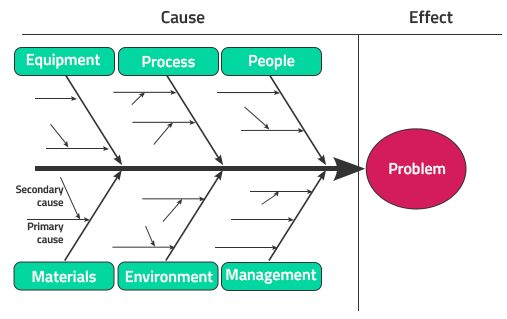One of the most important tasks for a project manager is the root cause analysis. No project in the world gets completed without any issues. Project managers deal with this reality every day. But knowing there is an issue or there will be one isn’t enough. Project managers need to get down to the root cause, identify what truly caused the issue, and how it can be avoided the next time, emphasizing what could have been done differently to land in the same soup again.
What is the Root Cause?
The root cause is the main underlying issue, the key cause for the occurrence of an issue or incident. The issue is only what is visible on the surface, like the tip of an iceberg. The root cause is generally hidden much deeper and needs to be found through thorough investigation. For instance, if the CrowdStrike-Microsoft failure earlier in 2024 is the issue, then the root cause would be the specific code written by a specific person that went into the release, which triggered the outage.
What is Root Cause Analysis?
Root cause analysis is a set of problem-solving techniques and tools. They help identify the root cause of an issue that has occurred or is occurring. The tools go beyond just identifying the root cause. They help one dig deeper into the contributive factors and instances that led to the root cause and what corrective actions can be taken to mitigate the issues as well as improve the business processes.
Issues and incidents in projects are usually never caused by one single factor. There are usually multiple smaller instances or factors that collectively contribute to an issue. Sometimes, these instances could have been occurring for a long time before their adverse effects became noticeable. Sometimes, they get ignored until it becomes unignorable. This makes root cause analysis extremely important. When you can get down to the base, the very root of the problem, you can also eliminate it from the root and prevent it from becoming a problem again.
Using Root Cause Analysis
Root Cause Analysis or RCA is one of the most used for problem identification and resolution. If an organization or team follows the usual quality management standards like Total Quality Management, Six Sigma, DMAIC, lean manufacturing, agile management, etc. root cause analysis protocols would likely already be in place for them.
Whenever there is a problem with a project that could adversely affect the outcomes, timelines, and resource needs, or hurt the client in any way, root cause analysis becomes essential. The techniques can be extended to any aspect of the business and are not limited to project management alone.
The unique thing about root cause analysis is that it is not one technique or method. Instead, it is a bunch of different techniques and tools that are all designed to serve the same purpose – identify the root cause and resolve the problem. Project managers and teams have the freedom to choose any of the techniques to conduct root cause analysis that fits their requirements and helps them achieve their goals.

The Five WHYs Technique
This is a very simple technique, so simple that rookies often find it hard to believe this is even a technique for root cause analysis. But rest assured, it is one of the most foolproof techniques. The technique is exactly what the name says – asking WHY five times. Minimum. When you ask why a problem happened and try finding answers to it, at some point you get to the bottom of things. What could be a deeper dive into problems than asking why they occurred, then asking why the response, and so on?
For example, a very high-stakes project is going to be delayed unexpectedly. Let’s do a root cause analysis for this with the five WHYs.
Why is the project delayed?
Because the resources the team had to borrow urgently from another team haven’t been available.
Why did we need resources from another team?
We did not have the capabilities needed for the issue at hand. Say, there was a security issue and the team did not have the right cybersecurity specialists so they had to be borrowed from another team. They have been occupied with their project and haven’t been able to allocate bandwidth to this project.
Why did we have a security issue?
There was a breach during development that was noticed too late. By the time the team realized, the cyberattack had already duplicated the libraries and caused enough damage.
Why did we notice too late and not take measures proactively during development?
Cybersecurity was not factored in when making the development plans so the project team did not have adequate security specialists.
See how this goes? We keep asking why and find that security was not factored in from the start and only added in as an afterthought by which time the damage had been done. This is the root cause. The serial question and answer exercise leads to the root cause and helps the teams sort out issues as well as prevent issues from happening again.
Fishbone Diagram
In essence, root cause analysis is about identifying the causes for something that has taken effect. Another good method of identifying causes is to make a fishbone diagram. The fishbone diagram is also known as the Ishikawa diagram or the Herringbone diagram. Why is it called so? Because the diagram looks like a fish skeleton. There is a central line which is like the fish’s spine and then there are lines that sprout up and down, each representing a cause for the issue, which looks like the skeletal structure.
This is what a fishbone diagram looks like:

Change Analysis
Change analysis is another popular technique for carrying out root cause analysis. The technique is used when we need to identify what would happen if a certain change was implemented, what would be needed to ensure effective implementation of that change and ensure pitfalls and problems are avoided. It can also be used in retrospect to identify any issues that a particular change might have caused and map out its impact.
The problem with this technique is it is very tedious. For there to be a comparison, there have to be situations with a change and without a change, that’s how you can compare what happens if there is a change. Forecasting a lot of things may not always be possible, when possible it may not always be accurate. The results of change analysis aren’t always conclusive. But it is still a good technique to get an idea of things and look for potential problems.
Causal Factor Analysis
This technique is best suited for single events. The technique involves charting out a timeline and identifying a causal factor in that. It is difficult to use this technique for very complex events that involve multiple factors. A lot of backtracking is involved, so perfect documentation and records are essential.
These are some of the techniques used by project managers to conduct root cause analysis to identify problems and fix them. A successful project manager needs to be well-versed in all techniques for root cause analysis. Modern project management software can be immensely helpful in conducting this analysis but knowledge of the techniques can be indispensable.
Prepare for the Project Management Professional Exam with Cognixia
The Project Management Professional (PMP) certification is the most sought-after project management qualification. PMP certification enables project managers to operate remotely across several sectors and from anywhere globally.
This PMP online training includes a variety of concepts. It explains the distinctions between project management & operations management. Cognixia’s PMP Certification Training has been intended to assist managers/professionals in managing projects more efficiently and effectively by utilizing the Project Management Life Cycle.
Cognixia – the world’s leading digital talent transformation company – offers learners the official PMP-PMI Certification Training. We provide an extensive online PMP training program that consists of multiple project management training modules. This PMP training course will cover a wide range of topics – taking you through various aspects of project management & operations management.
This PMP certification course has been designed to help you manage big projects more efficiently and effectively with the help of the Project Management Life Cycle.

